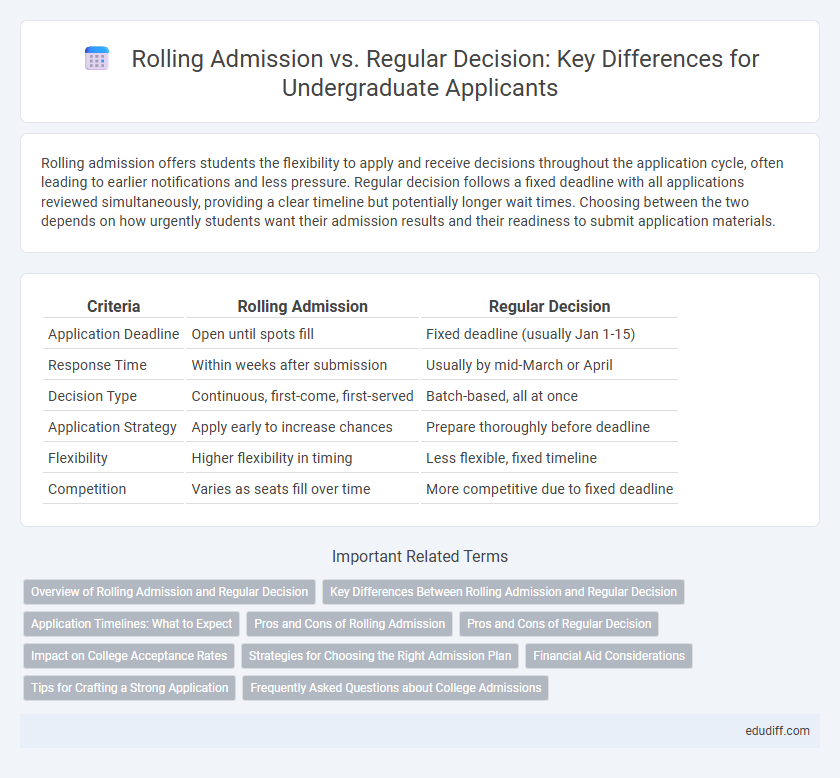Rolling admission offers students the flexibility to apply and receive decisions throughout the application cycle, often leading to earlier notifications and less pressure. Regular decision follows a fixed deadline with all applications reviewed simultaneously, providing a clear timeline but potentially longer wait times. Choosing between the two depends on how urgently students want their admission results and their readiness to submit application materials.
Table of Comparison
| Criteria | Rolling Admission | Regular Decision |
|---|---|---|
| Application Deadline | Open until spots fill | Fixed deadline (usually Jan 1-15) |
| Response Time | Within weeks after submission | Usually by mid-March or April |
| Decision Type | Continuous, first-come, first-served | Batch-based, all at once |
| Application Strategy | Apply early to increase chances | Prepare thoroughly before deadline |
| Flexibility | Higher flexibility in timing | Less flexible, fixed timeline |
| Competition | Varies as seats fill over time | More competitive due to fixed deadline |
Overview of Rolling Admission and Regular Decision
Rolling Admission allows undergraduate applicants to submit their applications at any time within a specified period, with decisions made promptly on a rolling basis, offering flexibility and faster responses. Regular Decision has a fixed deadline, typically in early January, with all applications reviewed simultaneously and notifications sent on a common date in the spring, providing a structured timeline. Understanding these distinct application timelines and decision processes helps students choose the submission strategy that best suits their needs and planning.
Key Differences Between Rolling Admission and Regular Decision
Rolling admission offers a flexible application timeline by reviewing applications as they arrive, granting earlier notifications and potential enrollment opportunities. Regular decision follows a fixed deadline, delivering admission results on a set date, allowing applicants more time to improve their credentials. Key differences include application deadlines, notification timing, and the ability to apply to multiple schools without immediate commitment.
Application Timelines: What to Expect
Rolling admission allows undergraduates to submit applications continuously, with decisions made within weeks of submission, enabling greater flexibility and early planning. Regular decision requires applicants to adhere to a fixed deadline, typically in early January, with notifications released in mid to late March, promoting a uniform evaluation timeline. Understanding these timelines helps students manage application preparation and response expectations effectively.
Pros and Cons of Rolling Admission
Rolling admission allows undergraduate applicants to submit materials and receive decisions continuously, offering flexibility and faster response times, which can reduce stress. The drawback includes limited scholarship opportunities and possible early filling of spots, reducing availability compared to regular decision deadlines. This model benefits students who are organized and decisive but may disadvantage those needing more time for application preparation.
Pros and Cons of Regular Decision
Regular Decision allows students more time to improve their academic records and submit a stronger application compared to Rolling Admission, with a fixed deadline fostering comprehensive preparation. However, the competitive nature of Regular Decision can result in lower acceptance rates due to the large volume of applicants evaluated simultaneously. Students accepted under Regular Decision benefit from a structured timeline that provides clear notification dates, aiding in efficient planning for housing, financial aid, and enrollment.
Impact on College Acceptance Rates
Rolling admission often leads to higher acceptance rates early in the application cycle due to continuous review and available spots, benefiting applicants who apply promptly. Regular decision pools applications until a fixed deadline, resulting in more competitive acceptance rates as colleges evaluate all candidates simultaneously. Understanding these dynamics helps undergraduates strategize submission timing to improve acceptance odds based on institutional admission practices.
Strategies for Choosing the Right Admission Plan
When selecting between Rolling Admission and Regular Decision, prioritize application timelines and flexibility based on individual readiness. Rolling Admission allows earlier notifications and multiple submission chances, ideal for students with a clear list of schools and completed materials. Regular Decision suits those needing extra time for test scores or improving transcripts, providing a structured deadline and often more scholarship opportunities.
Financial Aid Considerations
Rolling admission often provides earlier access to financial aid information, allowing students to explore scholarships and grants well before regular decision deadlines. Regular decision may offer more comprehensive financial aid packages but requires applicants to wait longer for results, potentially limiting their ability to compare offers. Students prioritizing financial aid should weigh the timing and availability of awards in each admission process to maximize funding opportunities.
Tips for Crafting a Strong Application
Highlight academic achievements and extracurricular involvements prominently to showcase a well-rounded profile, essential for both Rolling Admission and Regular Decision processes. Tailor essays to reflect genuine passion and align with the institution's values, increasing the chances of capturing the admissions committee's attention. Submit applications early when possible, especially for Rolling Admission, to leverage the advantage of ongoing review and enhance the likelihood of acceptance.
Frequently Asked Questions about College Admissions
Rolling Admission allows students to apply anytime within a specified period, receiving decisions promptly, whereas Regular Decision has a fixed deadline with decisions released on a set date. Frequently asked questions about college admissions often address differences in application timelines, decision speed, and chances of acceptance under each method. Understanding these distinctions helps applicants choose the best strategy based on their preparedness and admission goals.
Rolling Admission vs Regular Decision Infographic

 edudiff.com
edudiff.com